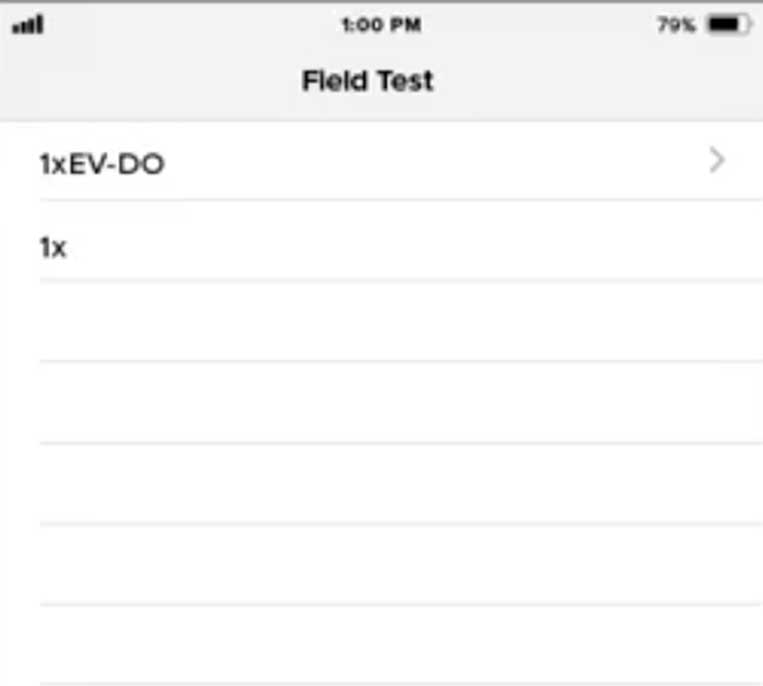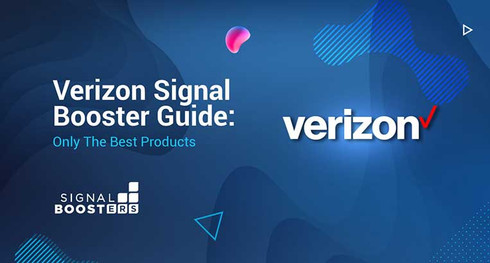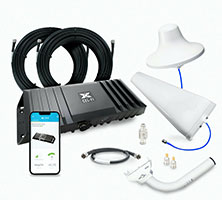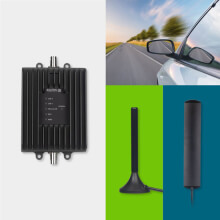Verizon Signal Booster Guide: Only The Best Products

Is There A Problem With Verizon?
Verizon consistently ranks among the best networks in the nation. However, no matter how strong Verizon's signals may be, it is possible for them to weaken due to factors beyond their control.
Obstructions both manmade and natural can lead to disruptions to your service, impeding your access to the cellular service needed to get through the day. These include, but are certainly not limited to, the following factors:
- Inside interference: Glass, metal, bricks, concrete, etc.
- Outside interference: Buildings, tall trees, mountains and hills, etc.
At their worst, these obstacles can even lower your bars to zero! This happens with pretty much any service provider, though, due to the way signals work, so consumers shouldn’t be too hard on their carriers when it happens.
For moments like these, it’s a good idea to get a third party signal booster. Don’t lose bars because of nearby structural issues blocking your ability to access your texts and emails or make phone calls. There are plenty of cell phone signal boosters out there to meet your home, office, or vehicle needs.
How You Can Improve Your Verizon Signal
There’s no magic to a signal booster. They work by amplifying existing signals, making it easier for you to take care of everything you need to do with little worry. The strongest devices are carrier-specific, however, all-carrier models provide flexibility.
We’ve done all the research needed to find the best of the best signal boosters to help keep your Verizon service running smoothly. What follows is a listing of our recommendations for home, office, and vehicles.
Our Top Verizon Signal Booster Recommendation for Home
Bolton Technical Victory Yagi/Panel Kit
- Best for small to midsize homes
- Boosts talk, text, and 4G/5G data
- Up to 4,000 sq ft coverage
- Up to +72 dB gain/li>
The Bolton Technical Victory is the most powerful multi-carrier cellular booster in its class. It features up to 72 dB gain and incredible uplink power. Your Verizon signal will significantly improve wherever you need it. Under best conditions, it can blanket up to 4,000 sq ft with strong, reliable Verizon reception. Equipped with the highest quality cellular antennas and cables, it delivers the strongest possible cell signal for multiple carriers.
There are two versions of this kit. One comes with a Yagi outdoor antenna and the other with an Omni outdoor antenna. The Victory Yagi/Panel dominates in areas with weak outside signals and fewer towers. The Victory Omni/Panel is the perfect choice for areas with strong outdoor signals and those wanting multi-carrier coverage. It's also easier to install.
Cel-Fi By Nextivity GO X
- 4G/LTE/5G coverage up to up to 15,000 sq ft
- Boost one carrier at a time
- Most powerful amplifier
- Multiple antenna options for any signal situation
The Cel-Fi GO X is the most powerful Verizon cellular booster you can get. Since it can only boost one carrier at a time, it features the highest gain on the market, up to 100 dB gain. Even with weak outside cell signal, your cellular devices will receive superior Verizon connectivity. Super customizable, you can pair it with different cellular antennas to maximize performance in any signal environment.
weBoost Home Room
- Boosts 4G/5G indoors for all carriers
- Up to 1,500 sq ft coverage
- Up to +60 dB Gain
The Home Room is a fantastic choice for those looking to boost signal in 1- 2 rooms. Best for areas no larger than 1,500 sq ft.
The Home Room is flexible and easy to set up. It comes with a flat window cable so that you don’t have to drill holes on your walls, great for those small apartments. The outside antenna comes with different mounting options, including a suction mount to install it on a window. best for those looking for a budget friendly and strong signals.
Our Top Verizon Signal Booster for Vehicles
Bolton Technical Velocity Vehicle Kit
- Boost talk, text, and 4G/5G data
- For everyday cars, trucks, and SUVs
- Up to +50 dB gain
- Simple installation
- Works with all North American wireless carriers
The Velocity Vehicle cellular signal booster is one of the best all-carrier vehicle signal boosters around. With high gain and high-quality cellular antennas, it gets you better Verizon reception in your vehicle anywhere on the road. Passengers who don't use Verizon will also enjoy a more reliable connection.
While this particular kit is best for your everyday vehicles, additional configurations are available to fit any vehicle.
Cel-Fi GO M
- Single-carrier amplifier
- Boosts talk, text, and 4G/5G data
- For any car, truck, RV, and boat
- Up to +65 dB gain
The GO M is easily the strongest Verizon car signal booster on the market, providing up to +65 dB gain. With the download of the Cel-Fi Wave app, you’re able to switch to another carrier such as AT&T, so you don’t have to worry about replacing this device if you ever leave Verizon.
weBoost Drive Sleek
- Cradle amplifier
- Boosts talk, text, and 4G/5G data
- For any car, truck, and RV
- Up to +23 dB gain
When you’re on the road, you definitely want to be as hands-free as possible if you have to communicate via smartphone. The weBoost Drive Sleek comes with a cradle mount, and it’s capable of holding a variety of devices, including some tablets. In general, you should see gains of about +23 dB, so you can use this in most cars, trucks, and even RVs.
In general, you’re going to see the best results when you use this signal booster in urban areas, but it’ll still get the job done if you need to drive somewhere rural.
Verizon Signal Booster for Commercial Buildings
Cel-Fi QUATRA for Verizon
- Boosts 4G and 5G indoors for Verizon
- Up to 200,000 sq ft coverage
- Up to +100 dB Gain
The best, strongest Verizon signal booster for commercial buildings is roughly 1000x more powerful than the comparative leading all-carrier booster - a difference from +70 dB to +100 dB, in fact.
This model is made up of two parts:
- A network unit (NU), which boosts existing signals for up to four coverage units.
- A coverage unit (CU), which broadcasts these boosted signals signals in an area of up to 50,000 square feet. If you fully stack your Quatra, you’re looking at a possible coverage of around 200,000 square feet.
Also of note, rather than coax cables, the Cel-Fi Quatara instead requires power of ethernet (PoE) Cat5e cables to enhance the quality of digital signals, as well as keep them running for longer than they would with analog equipment. Cable runs are about 3x the size of RG-6, LMR400, and similar cables.
weBoost for Business Office 200
- Boosts 4G/LTE/5G Indoors for All Carriers
- Up to 35,000 Sq Ft Coverage
- Up to +72 dB Gain
The weBoost for Business Office 200 is a powerful signal booster designed to improve T-Mobile, AT&T, and Verizon signals simultaneously. It’s able to communicate with far distanced towers to provide you with the best possible signal in large residential buildings and commercial buildings no larger than 35,000 sq ft. Not to mention, it features XDR technology, which allows the booster to automatically adapt to any changes in outside signal to prevent it from being overloaded.
Why It’s Not 100% Verizon’s Fault, It’s Also Your Building Material

Indoor cell phone use accounts for the highest rate of dropped calls, given that 80% of all calls are made indoors. In fact, over 72% of instances of smartphone use indoors contends with some form of dropped calls, issues with voice quality, and/or slowed down internet.
The reason why?
Pretty much any network, Verizon included, can take a dip in quality because of the materials making up your home or commercial building. Distance between you and a cell tower will always be a factor in call, text, and internet quality, but outside obstructions like trees, tall buildings, mountains, and others can also lead to issues. The top reason why your calls are dropping is building materials and the layout of the building you’re in, though.
The following are the 7 most common materials that can compromise your cellular access’ quality:
- Metal: Most types of metal will be problematic to your signal. The most common metals used in building - in no particular order - are brass, copper, aluminum, steel, iron, tin, etc.
- Low-E- Glass: Although a great choice for making a building energy efficient and eco-friendly, it’s also a major reason why you might deal with signal issues indoors.
- Brick/Concrete: The thickness and durability of brick and concrete are capable of weakening - if not outright blocking - your service.
- Plaster /Drywall: Although less of an issue than brick and concrete, plaster and drywall can still dampen your ability to make calls and texts.
- Wood: Thicker plans of wood can function similarly to plaster and drywall when interacting with cell signals.
- Thick Walls: Thick walls are at their most annoying nearest the center of the building.
- Electromagnetic Interference: Standing too close to wireless machines, TVs, computers, and other devices that emit RF noise may also cause disrupts.
You could be standing immediately next to a cell tower and still experience some hiccups on your service due to these and other building materials. A signal booster is a worthwhile investment in most situations.
Verizon Frequency Bands
The following are the major Verizon frequency bands. Understand that local and statewide service can be updated.
| Verizon Frequency Bands | |
| Band 17 | 700 MHz |
| Band 13 | 700 MHz |
| Band 5 | 850 MHz |
| Band 4 | 1700-2100 MHz |
| Band 25 | 1900 MHz |
Finding Your Verizon Cell Phone Signal Strength & Cell Tower Location
Bars are often your first indicator of cell phone signal strength, but they aren’t always the most reliable. But they aren’t the exclusive way to gauge access.
dBm is actually your best bet in seeing just how strong your cell phone is; this is the metric by which signals are measured. -50 dBm is the ideal, and should show up as full bars, and -120 dBm is the poorest possible signal.
Use the following methods to find your dBm :
Field Test Mode (Using Your Cell Phone)
For iPhone Users:
Thanks to Apple’s removal of easy access to your dBm in Field Test Mode, it’s a little harder to get a reading - especially since there’s two different chipsets, Intel and Qualcomm.
This is how to find the dBm of your iPhone with the Qualcomm chipset for Verizon customers:
- On phone mode, call: *3001#12345#*.
- If you see the following options: 1x EV-DO and 1x, congrats, you can find your dBm.

- Tap on 1x EV-DO.
- The number next to RX AGC0 is your dBm reading.
Don’t fret if you’re unable to find your dBm this way. There are plenty of smartphone apps that can reliably give you all the info. Scroll below for a list.
For Android Users
Thanks to Android’s open system, it’s a little easier to find your dBm. Keep in mind that, despite these being general instructions, the details can vary based on who manufactured your phone. Luckily, hewing closely to these will still get you to where you need to be.
- Access your Settings.
- Tap on About phone.
- Tap on Status.
- Tap on SIM status.
- Your dBm reading should be under Signal strength.
Smartphone Apps
Apps are extremely beneficial when you need information about the closest cell phone tower and dBm readings. Which ones to pick is another story, though. We have our favorites, though. You can’t go wrong with any of the following apps to test your cell phone or smartphone signal speeds:
For iPhone Users:
For Android Users:
- Network Cell Info (Highly Recommended)
- LTE Discovery (Highly Recommended)
Take advantage of our system design and installation services. Learn more or call us for a free consultation: 1-800-969-8189.
Need to Boost Signal for Another Carrier?
Contact Us
We’re here to assist with any issues you might be experiencing with both Verizon signals and your Verizon signal booster. Contact us today.
Table of Contents

Recent Posts












